Common names from other countries
Classification / Names / Names
Populärnamn | synonymer | Catalog of Fishes (gen., sp.) | ITIS | CoL | WoRMS
Environment: milieu / climate zone / depth range / distribution range
Ekologi
Djupbottenlevande; djupintervall 0 - 6000 m (Ref. 356). Boreal; 90°N - 0°S, 97°W - 180°E
Atlantic Ocean and the Arctic: North Atlantic Ocean, Arctic Ocean, Baffin Island, Magdalen Island, Russia, Canada (Ref. 1394). Pagophilus groenlandicus groenlandicus: Newfoundland, Jan Mayen (Norway), Baffin Bay, Greenland Sea, Nova Scotia, Greenland, Iceland; and vagrants in Virginia, Scotland, Germany, France; Pagophilus groenlandicus oceanicus: Barents Sea, Russia, White Sea (Ref. 1522).
Length at first maturity / Size / Vikt / Age
Maturity: Lm ? range ? - ? cm Max length : 190 cm TL hane/ej könsbestämd; (Ref. 1394); 180 cm TL (female); publicerad maxvikt: 135.0 kg (Ref. 1394); publicerad maxvikt: 135.0 kg
Live chiefly in pack ice, but can be found away from it in summer. Feeds on a variety of crustaceans and open-water fishes during migration, and switch to several varieties of bottom dwelling fishes in summer on the northern grounds (Ref. 1394).
Jefferson, T.A., S. Leatherwood and M.A. Webber. 1993. (Ref. 1394)
IUCN Red List Status (Ref. 130435: Version 2024-1)
CITES status (Ref. 108899)
Not Evaluated
Not Evaluated
Human uses
Fiskeri: kommersiell
FAO - fiskeri: landings, species profile | FIRMS (Stock assessments) | FishSource | Sea Around Us
Verktyg
Internet-källor
Estimates based on models
Preferred temperature
(Ref.
115969): -0.9 - 4.1, mean 0.6 (based on 2101 cells).
Vulnerability
High to very high vulnerability (71 of 100).
Price category
Unknown.
